Employee performance management is no longer just about yearly reviews. It is a system that helps teams stay aligned, motivated, and productive. Companies that do this well see good results.
A study by Bersin by Deloitte found that organizations with strong performance management practices are 1.5 times more likely to beat their peers financially.

But, a huge problem is that traditional methods like spreadsheets and manual check-ins doesn't allow room for scaling. As teams grow, managers need to track progress, and give feedback more quickly than expected.
This is where performance management software platforms can make a difference. These platforms simplify the process, reduce admin work, and give leaders the insights they need to support employees better.
We’ve rounded up 12 of the most popular and highly used performance management platforms to help you make an informed decision. We'll discuss why we picked each platform, and state its key features so you can decide which one fits your organization best.
Best Performance Management Software: Comparison Table
Best Performance Management Software Platforms: Individual Review
Each of the following performance management software carries the necessary capabilities and features you'd require to effectively manage and enhance your organization's performance.
1. ThriveSparrow
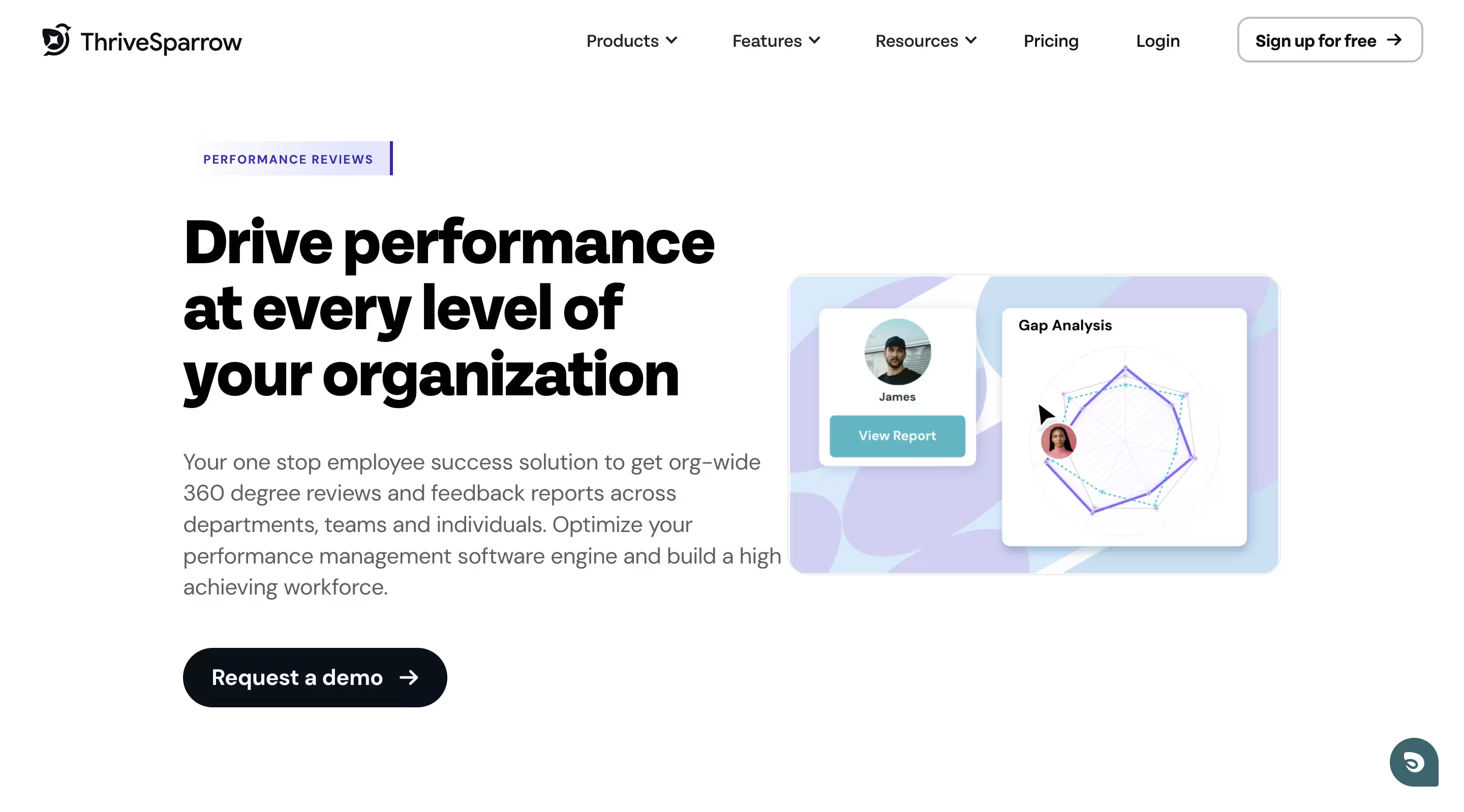
ThriveSparrow is a performance management platform designed to connect individual goals with business outcomes. It gives managers the tools to guide employees, and employees the clarity to grow in their roles. By combining feedback, reviews, and goal tracking in one place, it makes performance management less of a chore and more of a continuous process.
ThriveSparrow Key Features
- Continuous Feedback: Make feedback timely and useful. Employees and managers can share coaching and recognition in the moment instead of waiting for annual reviews.
- Setting Goals and OKRs: Align team and individual goals with company priorities. Clear objectives keep employees focused and give leaders full visibility into progress.
- Streamlined Reviews: Visually appealing reports give instant takeaways on employee strengths and improvement areas. Moreover, managers save time, and employees get feedback they can act on.
- Development Plans (PDPs): Create structured growth paths. Employees map future skills, and managers spot training needs to support career development.

Why ThriveSparrow?
ThriveSparrow turns performance management into a strategic advantage rather than an HR obligation. The platform helps you build a culture where feedback flows naturally and employees see clear paths to advancement. What sets it apart is how it connects the dots between daily work and long-term growth.
If you want performance management that actually moves the needle on engagement and retention, ThriveSparrow makes that happen without overwhelming your team with complexity.
Pricing Details
ThriveSparrow offers 4 pricing plans,
Engage: $3/employee/month
Kudos: $2/employee/month
Performance: $5/employee/month
Goals [OKRs}: $3/employee/month
If you don't know which plan is right for you, consider getting a free trial. Explore ThriveSparrow to your heart's content and even run your first performance review for absolutely free.
2. factoHR
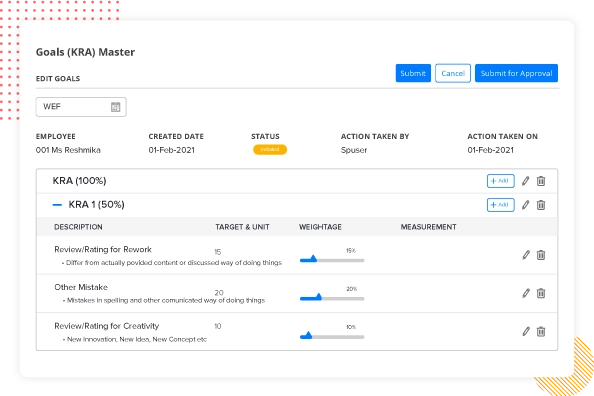
factoHR is a comprehensive HR and performance management platform that helps businesses align employee objectives with organizational goals. The platform saves time through automation and combines performance tools with core HR functions like payroll and attendance. This integration streamlines operations and gives teams more time to focus on growth.
factoHR Key Features
- Measure Performance with Goals: factoHR lets you set various measurement parameters for each goal. You can use numbers, stars, or other metrics to evaluate goals across multiple dimensions. This flexibility helps you assess performance in ways that match your business needs.
- Informative Dashboard: The platform provides a bird's eye view of employee performance ratings. You can quickly identify who performs well and who needs additional training. The dashboard makes performance trends visible at a glance.
- Flexible Review Cycle: factoHR handles the complexity of review cycles for you. You configure the review cycle once, set up the approval hierarchy, define incentive types, and select which employees to include. The system runs the rest automatically.
- Easy Accessibility: The mobile application gives managers freedom to work from anywhere. They can create goals and conduct review cycles at their convenience without being tied to a desk.
- Payroll Integration: factoHR calculates salary and incentives based on performance data. This direct link between performance and compensation helps engage and motivate employees by making rewards immediate and transparent.
Why We Chose factoHR?
We chose factoHR because it solves a common headache—juggling too many disconnected systems. Instead of using one tool for performance reviews, another for payroll, and yet another for attendance, you get everything in one place. This means no more manual data transfers or reconciliation errors.
What really stood out was how performance directly triggers payroll changes. Hit your targets, and the system automatically adjusts your compensation. No waiting, no administrative delays. For companies that want to simplify their HR tech stack without sacrificing functionality, factoHR delivers exactly that.
Pricing Details
factoHR offers the starting core plan at INR 4999 for 50 employees and requires INR 69 for each additional employee.
3. BambooHR
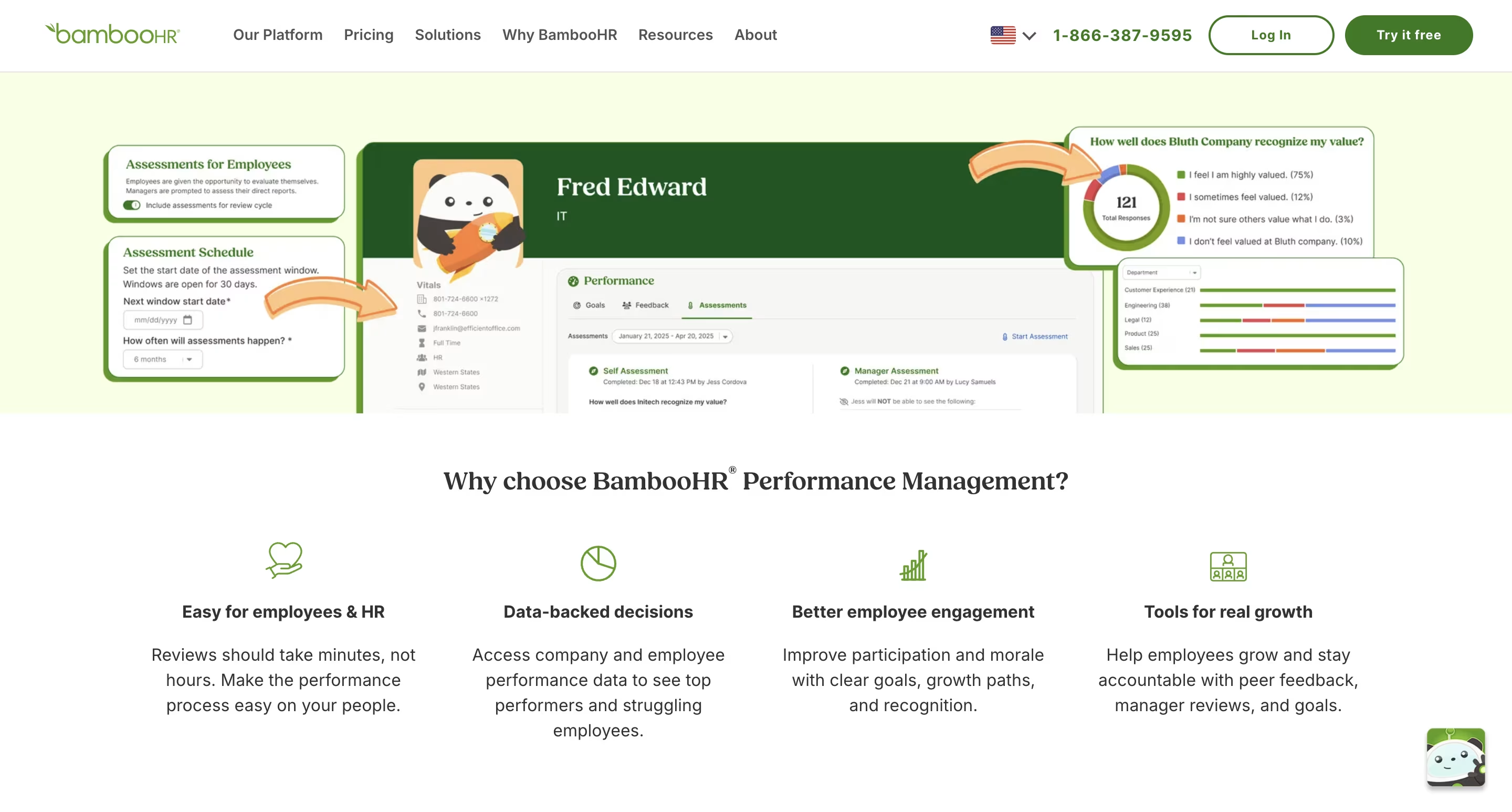
BambooHR is a solid choice for small-to-mid sized teams who want performance management tools that feel human, not like extra work. It integrates nicely with other HR functions and emphasizes simplicity, feedback, and alignment. The platform works best for organizations with 50-300 employees who want a unified HR system without juggling multiple disconnected tools.
BambooHR Key Features
- Integrated HR Suite: BambooHR combines performance management with core HR data. You get a complete picture of your workforce in one place. Leaders can view employee performance alongside hiring records, time off, and other HR information for holistic insights.
- Automated Review Cycles and Reminders: The platform lets you set up recurring review cycles and goal progress checks. The system sends automated reminders so reviews stay on track. Managers don't need to manually chase down performance assessments.
- 360-Degree & Peer Feedback Options: BambooHR supports feedback from multiple sources including peers, direct reports, and managers. Employees get a well-rounded view of their performance. Managers can identify strengths and gaps more accurately.
- Reports & Insights: The platform generates performance reports that track goal completion, feedback cycles, and assessments. You can see which teams thrive, which ones need support, and where performance trends are heading across the organization.
- Customizable Performance Reviews: BambooHR adapts to your review schedule. Whether you run quarterly check-ins or annual reviews, you can tailor the process to match your company culture and needs.
- Employee Self-Service: Employees can take ownership of their development through self-service features. They can set goals, request feedback, and stay actively engaged in their growth without waiting for manager input.
Why We Chose BambooHR?
We chose BambooHR because it eliminates the friction that comes with managing HR and performance separately. Small and mid-sized companies often struggle with cobbling together different tools that don't talk to each other.
BambooHR solves this by putting everything under one roof. You'll track performance by seeing it alongside hiring data, time off patterns, and compensation history. This context matters when making decisions about promotions, raises, or development plans. The automated reminders also prevent reviews from falling through the cracks, which happens constantly when processes are manual. If you want performance management that integrates seamlessly with your existing HR workflows, BambooHR delivers that without a steep learning curve.
Pricing Details
BambooHR offers a 7-day free trial so you can test the platform. For full pricing, you’ll need to contact their team directly for a custom quote.
4. Lattice
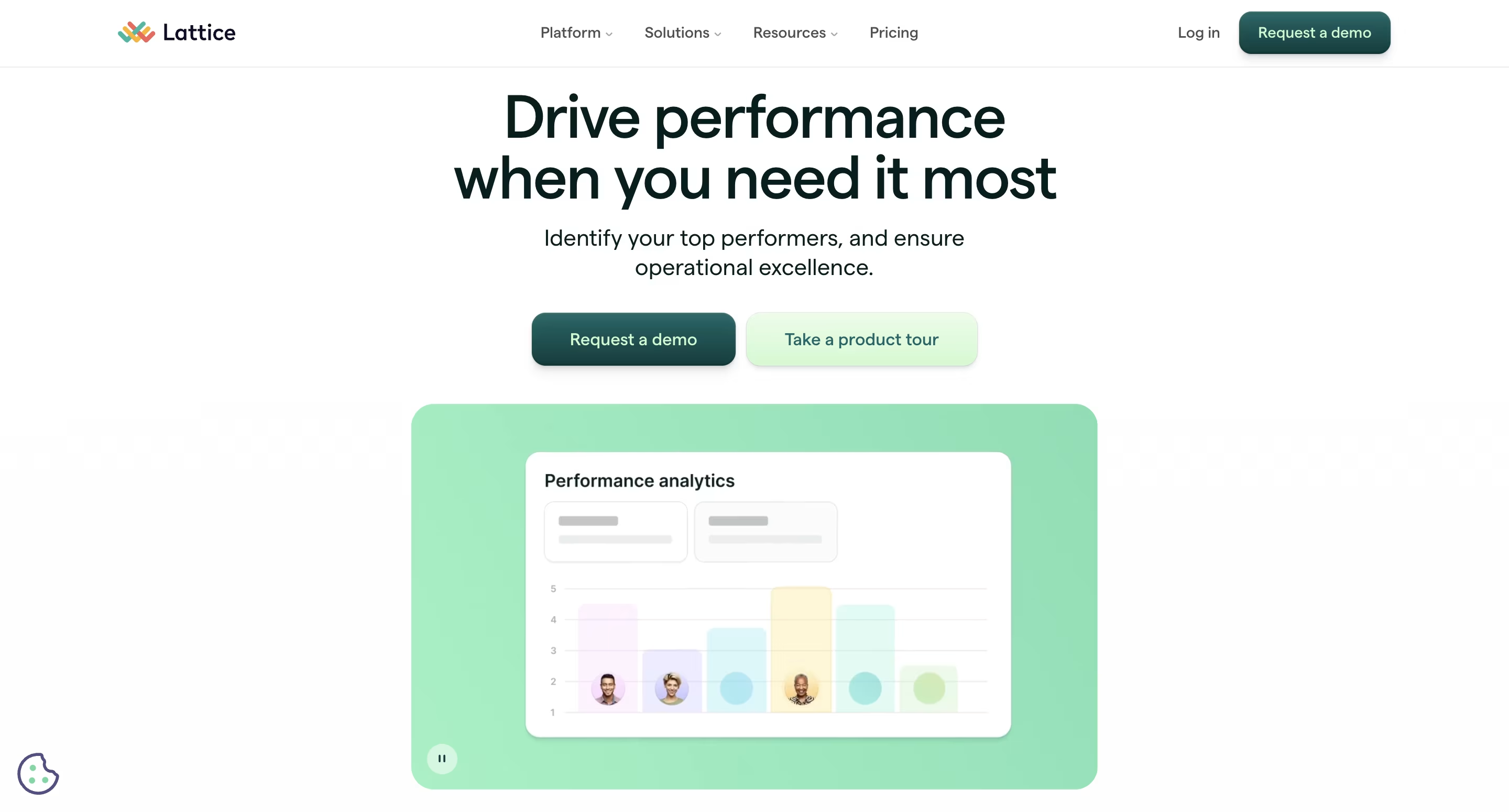
Lattice is a full-suite platform built for organizations that want to elevate their performance management beyond just reviews. It focuses on ongoing feedback, growth, and alignment. The platform supports small teams all the way up to large enterprises. It offers tools that help managers, HR teams, and employees work more clearly and intentionally.
Lattice Key Features
- Performance Reviews & Talent Reviews: Lattice streamlines formal reviews and helps structure conversations about long-term potential. The platform makes performance conversations more consistent and helps companies avoid vague feedback.
- 1:1s, Weekly Updates, Feedback & Praise: Managers can run regular check-ins and give real-time feedback or praise. This keeps performance visible throughout the year and supports continuous improvement rather than relying solely on annual reviews.
- OKRs & Goal Tracking: The platform lets you set company, team, and individual objectives in one place. You can track progress, see updates across the organization, and ensure everyone stays aligned with business priorities.
- AI-Powered Insights & Reports: Lattice includes dashboards and trend reporting tools to spot bottlenecks or risks. Leaders can use these reports to make informed decisions about talent development and performance strategies.
- Performance Improvement Plans & Continuous Coaching: When someone struggles, Lattice allows you to set up structured improvement plans. You can follow up with coaching and feedback to help get performance back on track with clear documentation.
Why We Chose Lattice?
We chose Lattice because it addresses the full spectrum of performance management, not just the review cycle. The 1:1 tools and weekly updates create consistent touchpoints between managers and employees, which prevents small issues from becoming big problems.
The AI-powered insights also stood out—they help you spot patterns you might miss manually, like which teams face recurring bottlenecks or where engagement dips. For companies that want to build a culture of continuous development rather than just checking compliance boxes, Lattice provides the infrastructure to make that shift real.
Pricing
Lattice provides a pricing plan starting at $11 per user per month, with additional features available in premium plans.
5. Leapsome
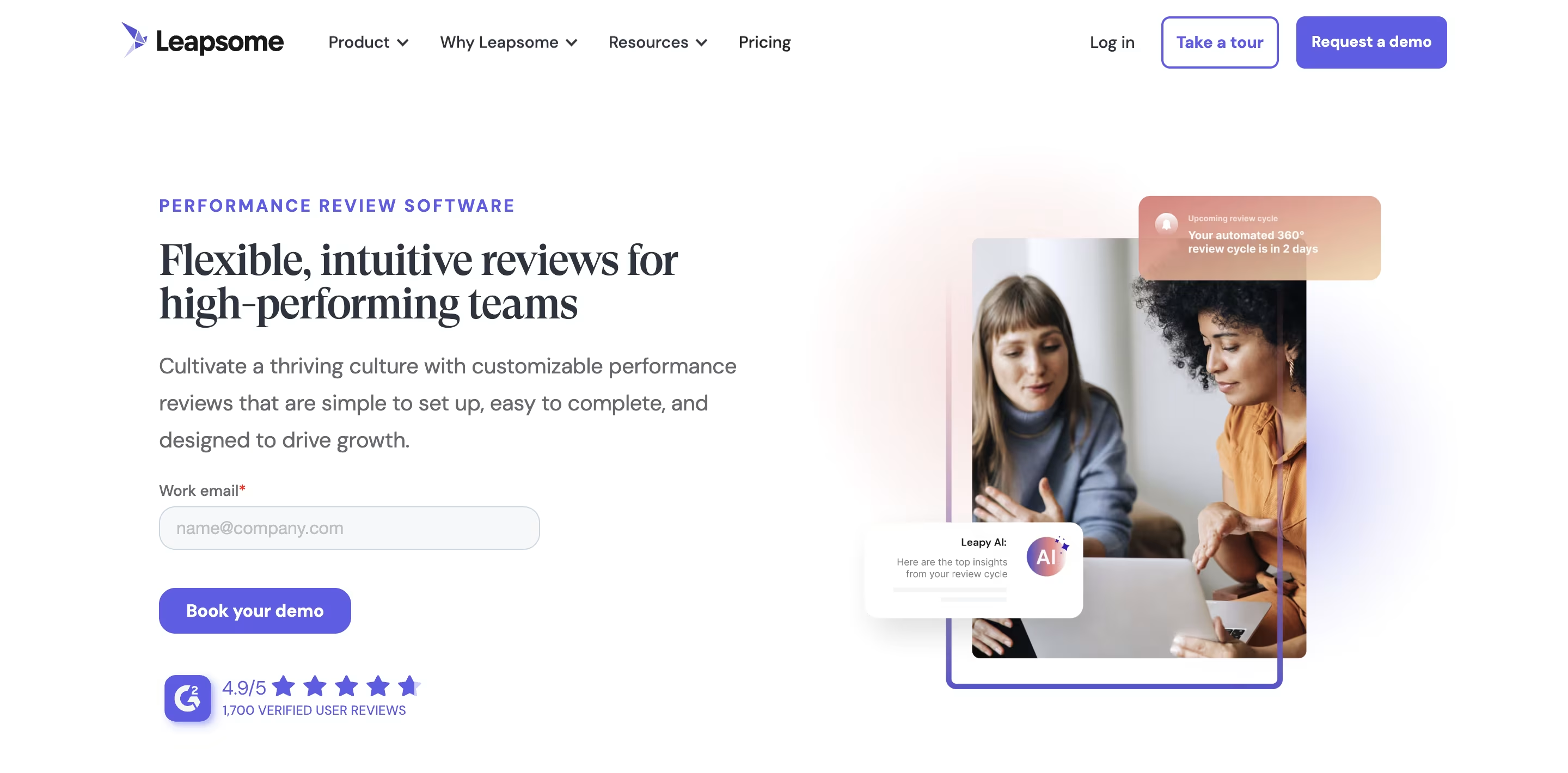
Leapsome is an end-to-end HR platform built to combine performance, feedback, learning, and goals in a people-first way. It's designed for teams that want ongoing growth, alignment, and actionable insights rather than one-off annual reviews.
Leapsome Key Features
- All-in-One HRIS + Performance Tools: Leapsome handles core HR tasks (employee records, payroll, time tracking, onboarding) alongside performance management features like reviews, 1:1s, feedback, and goal tracking. This helps reduce tool silos and keeps data consistent.
- Goals & OKRs + Feedback & 1:1s: The platform makes tracking OKRs or objectives transparent across teams. Combined with frequent feedback, praise, and structured one-on-ones, teams stay aligned and managers can intervene early when targets slip.
- Engagement, Surveys, and Learning: You can regularly survey your workforce to measure engagement, gather insights, and feed that data back into development programs. Leapsome also supports learning modules to build skills based on feedback.
- AI-Powered Insights & Coaching: Their “Leapy AI” features turn raw data into useful recommendations — like spotting which teams are lagging, suggesting next steps, or helping manager coaching. This reduces blind spots and keeps things moving.
- Customizable Workflows & Strong Integrations: Leapsome supports flexible review templates, permissions, and workflows. It also integrates with tools you may already use like Slack, calendars, payroll, and HR systems. That makes rollouts smoother.
Why We Chose Leapsome?
We chose Leapsome because it integrates learning and engagement surveys directly into the workflow. This means you're not just measuring performance—you're actively building it through targeted skill development. The AI coaching assistant also impressed us because it doesn't just report data, it recommends actions. Instead of staring at dashboards wondering what to do next, managers get specific guidance on where to focus their energy. For organizations that view performance as part of a broader people strategy rather than an isolated HR task, Leapsome makes that holistic approach practical.
Pricing Details
Book a demo with Leapsome to learn about custom pricing for your organization.
6. 15Five

15Five offers a full performance management suite focused on feedback, fairness, and growth. It provides tools that help companies run better review cycles, spot high-performers, and keep employees engaged throughout the year.
15Five Key Features
- Holistic Review Cycles: You can set up review cycles in as little as 15 minutes. The platform supports multiple sources of feedback including managers, peers, and direct reports. This gives a more rounded view of employee performance rather than relying on a single perspective.
- Calibration & Reporting: 15Five helps remove bias by allowing managers to calibrate ratings across departments. Reports let you see performance by role, department, or demographic group. This makes decisions on pay and promotions fairer and more transparent.
- Compensation & Career Paths: The platform integrates performance with compensation decision-making. Employees can see career paths and understand what they need to achieve for advancement. This clarity helps with retention and motivation.
- AI-Assisted Review Tools: 15Five provides AI support for writing reviews, reducing bias, and making feedback faster. The tools help managers craft more meaningful feedback without spending hours on each review.
Why We Chose 15Five?
15Five's career pathing feature also stood out because it answers the question every employee eventually asks: "What do I need to do to move up?" When employees see a clear path forward tied to measurable performance, they stay engaged and motivated. If fairness and transparency matter to your organization, 15Five builds both into the system.
Pricing Details
15Five's Perform plan starts at $10 per user per month, with combined features of Engage available at $16 per user per month.
7. Engagedly
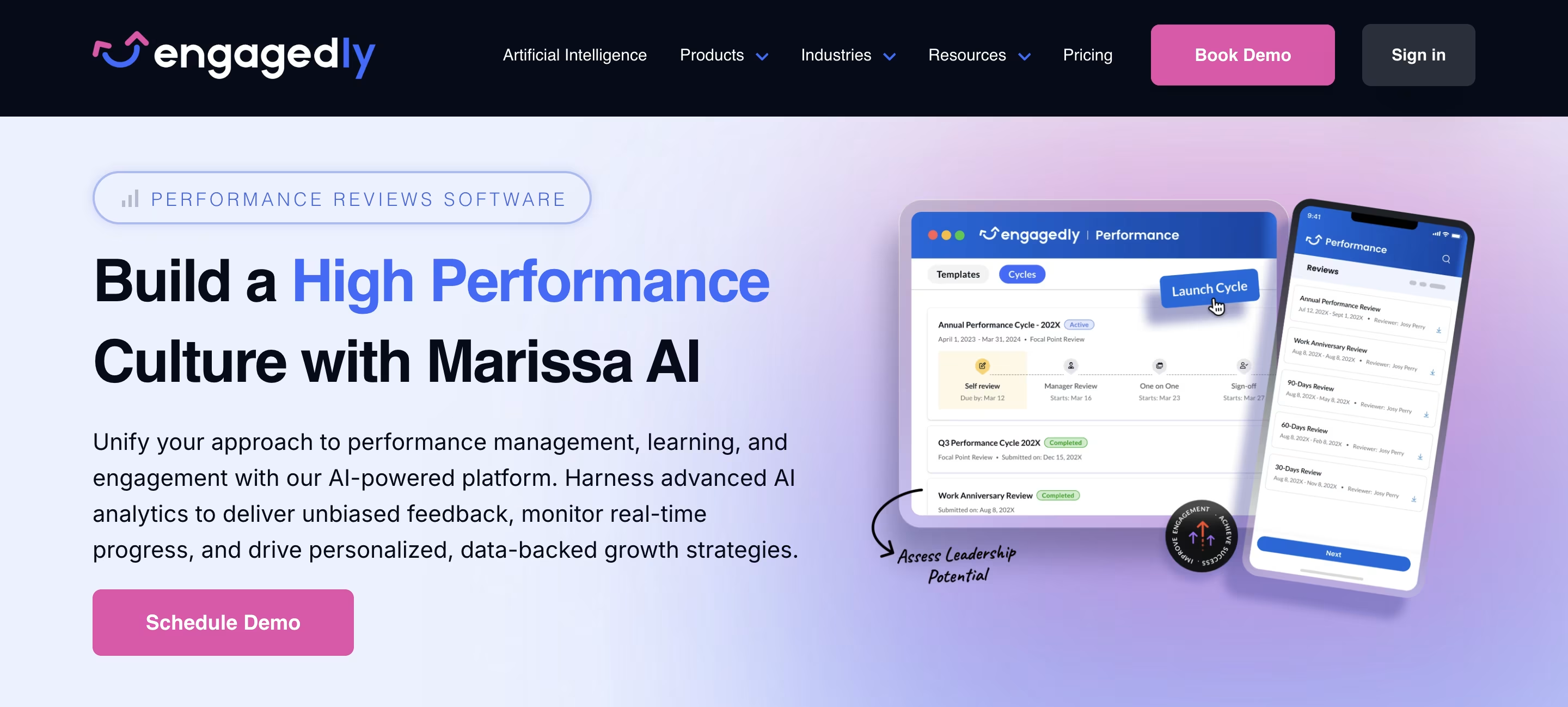
Engagedly is a robust performance management software that emphasizes employee engagement through gamification and social collaboration. The platform's performance review module focuses on fairness, growth, and smart feedback. It's built for organizations that want a system supporting ongoing improvement, insights, and alignment across all levels.
Engagedly Key Features
- Custom Review Templates & Personalized Process: You can choose how often to run reviews and adjust rating scales to match your needs. The platform supports skip-level reviews, letting employees be reviewed by someone above their manager. You can use different workflows for different teams based on their unique requirements.
- Fairness & Talent Identification: Engagedly helps reduce bias with calibration tools that keep ratings consistent across departments. The platform supports 9-box assessments to spot leadership potential and identify high performers who are ready for advancement.
- Continuous Feedback & 360-Degree Reviews: The platform supports multi-rater feedback from peers, direct reports, and managers. Employees can give or receive feedback continuously. This keeps performance visible throughout the year instead of limiting it to formal review periods.
- Development Plans & Growth Support: Engagedly provides development recommendations and personalized growth paths. The platform keeps feedback actionable by helping employees understand where to improve and how to get there with specific steps.
- AI & Analytics Support: Engagedly includes advanced metrics and analytics to track performance trends and identify gaps. Managers can make better decisions using data rather than relying on gut feelings or incomplete information.
Why We Chose Engagedly?
We chose Engagedly because it turns performance management into an engaging experience rather than a dreaded obligation. The gamification and social collaboration features change how employees interact with the system they actually want to participate instead of treating it like paperwork. The 9-box assessments particularly impressed us because they help identify future leaders before you desperately need them.
Many companies scramble when a leadership position opens up, but Engagedly helps you spot and develop high-potential employees early. The calibration tools also matter because they protect against the common problem where one manager rates generously while another rates strictly, creating unfairness across teams. For organizations that want performance management to drive engagement and strategic talent decisions, Engagedly delivers on both fronts.
Pricing Details
Engagedly starts at $5 per user per month that comes with Goals and OKRs as well.
8. Culture Amp
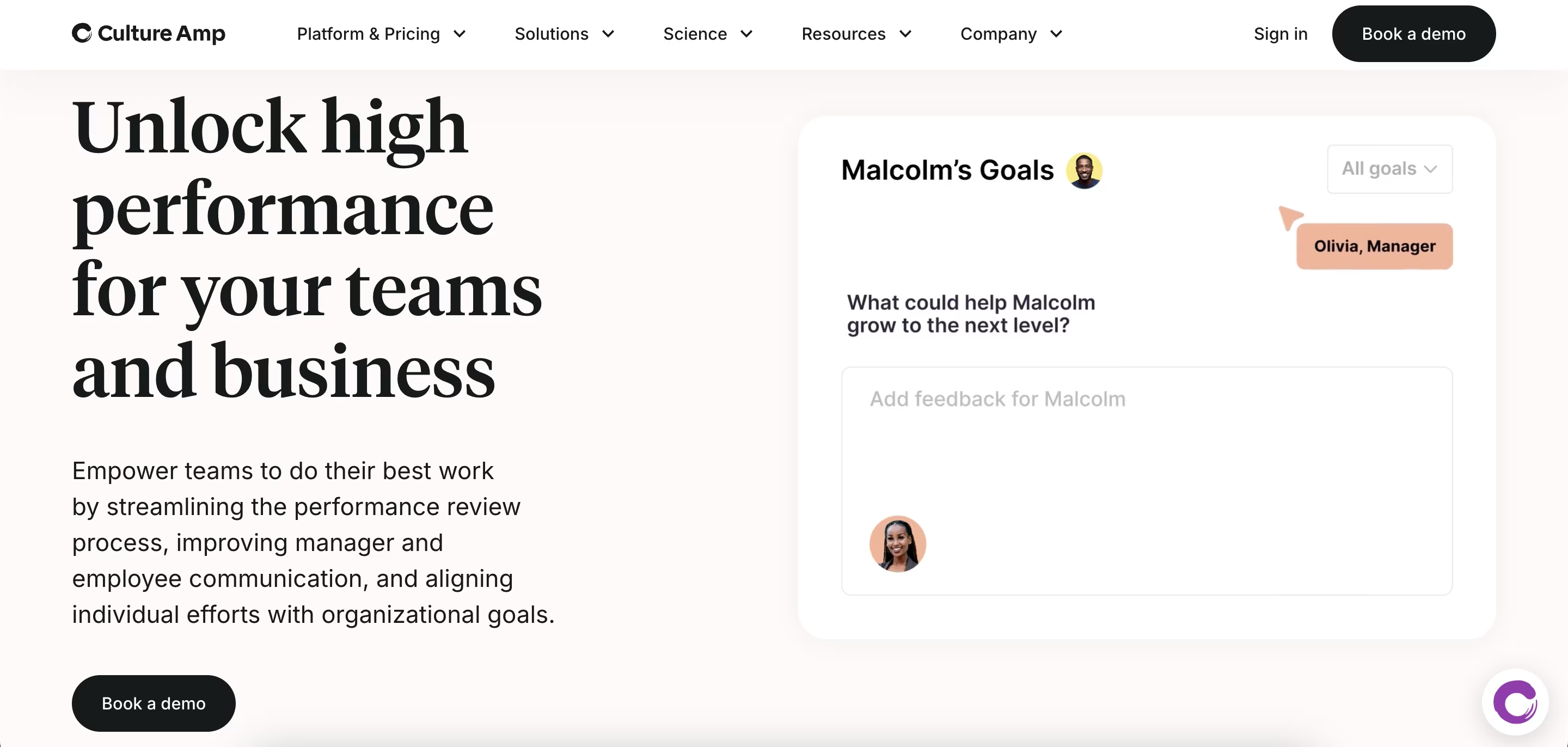
Culture Amp Perform is a people-focused performance management platform built for teams that want continuous feedback, fair evaluations, and data-driven growth. It helps reduce bias, align goals, and make performance conversations more frequent and meaningful. It’s ideal for organizations moving away from outdated annual reviews and toward a transparent, agile performance culture.
Culture Amp Key Features
- Continuous Feedback: Supports quick check-ins and ongoing feedback loops so performance stays visible all year—not only during review cycles.
- Performance Reviews & Calibration: Offers structured review cycles with calibration tools that remove rating inconsistencies. This helps ensure evaluations, promotions, and rewards stay fair across teams.
- 1:1 Conversations: Provides a simple space for managers and employees to discuss goals, progress, challenges, and next steps through regular private check-ins.
- Goal Management & Insights: Allows teams to set clear goals, track progress, and align work with company priorities. Leaders also get insights to spot strengths, gaps, and opportunities for support.
- Skills Coach & Growth Plans: Identifies skill gaps and recommends learning paths so employees know exactly what to develop next.
Why We Chose Culture Amp Perform?
We chose Culture Amp Perform because it blends continuous feedback, recognition, and structured reviews in a way that feels natural for modern teams. Most platforms focus heavily on the review cycle, but Culture Amp makes performance a year-round habit. The calibration tools stood out because they help keep ratings consistent across managers—something many growing teams struggle with.
We also liked how “shoutouts” and 1:1s are integrated directly into the workflow, making feedback frequent rather than forced. For companies that want a performance system rooted in fairness, psychology, and employee development, Culture Amp Perform delivers the right balance.
Pricing Details
You need to contact their Sales team for a custom quote.
9. ClearCompany
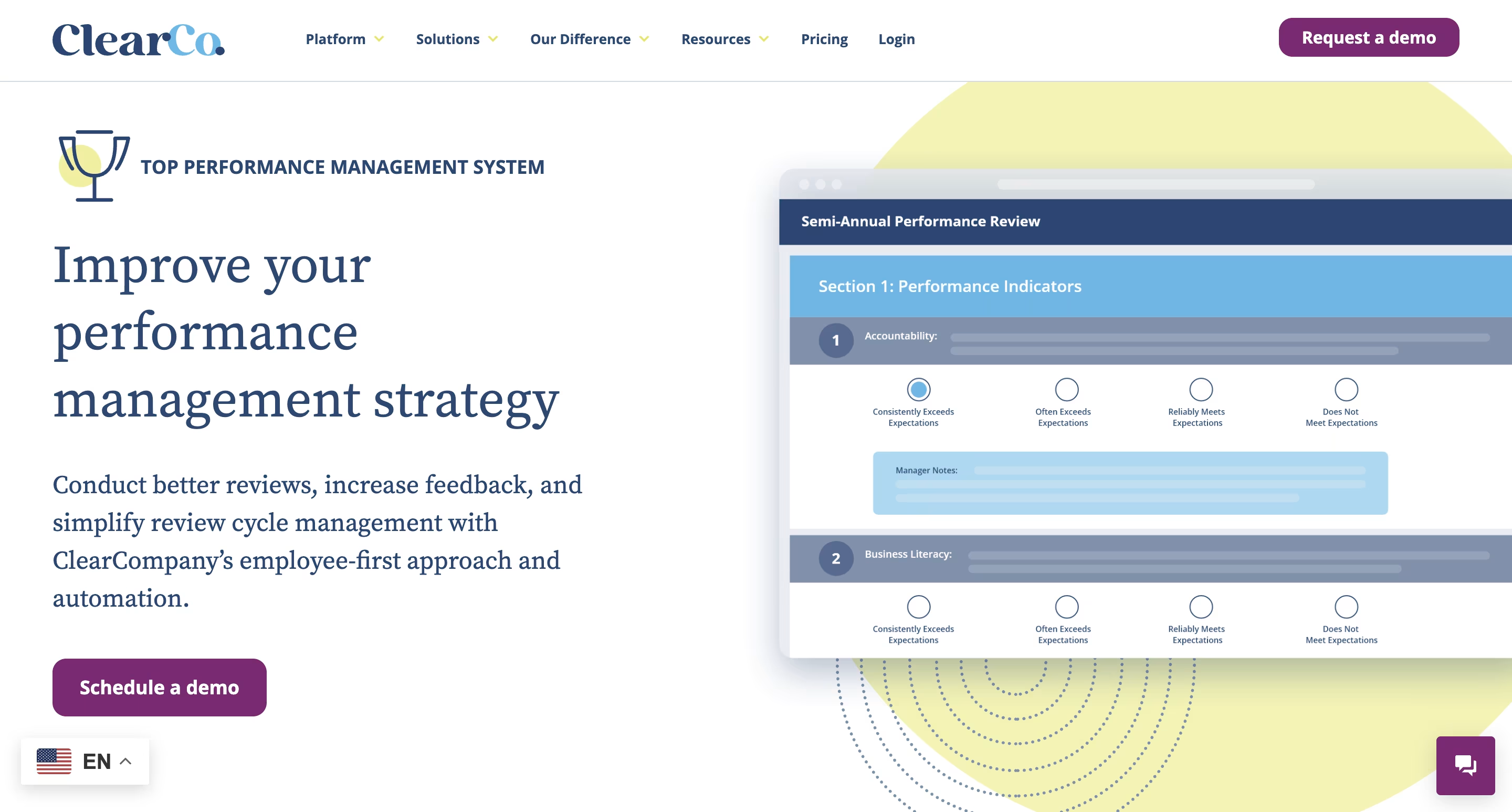
ClearCompany is a strong performance management platform built to streamline reviews, improve alignment, and support meaningful employee growth. It offers flexible review cycles, solid analytics, and smart automation to reduce admin work and keep performance processes consistent. It’s ideal for organizations with diverse teams, multiple review types, and a need to reduce manual overhead.
ClearCompany Key Features
- Custom Review Cycles & Templates: Run quarterly, semi-annual, annual, or new-hire reviews using pre-built templates or custom workflows. Supports 360-degree, competency-based, role-based, and goal-linked reviews.
- Workflow Automation & Participation Tracking: Automates reminders, tracks review progress, and manages different participant roles so reviews stay on schedule and participation stays high.
- Mobile & Multilingual Access: Employees and managers can complete reviews on mobile devices and in their preferred language. Goals, recognition, and performance updates are easy to view, keeping everyone aligned.
- Goal Planning & Continuous Feedback: Provides tools to set clear goals, align them with company objectives, and maintain momentum through frequent feedback and informal coaching.
- Reporting & Analytics: Offers dashboards, drill-down reports, and 9-box grids for insights into performance trends, goal alignment, manager scoring, review progress, and high-potential identification.
Why We Chose ClearCompany?
We chose ClearCompany because it gives teams the flexibility to run performance reviews their own way without adding extra work. The automation features stand out—they remove the hassle of chasing participants and tracking progress, which is a major pain point for HR teams.
The multilingual and mobile access also matter, especially for companies with distributed or frontline teams. ClearCompany’s mix of flexible reviews, analytics, and clear insights helps organizations maintain fairness while scaling their performance processes smoothly. It’s a great fit for teams that want structure without losing flexibility.
Pricing Details
Get a quote from ClearCompany on 3 different modules.
10. Small Improvements
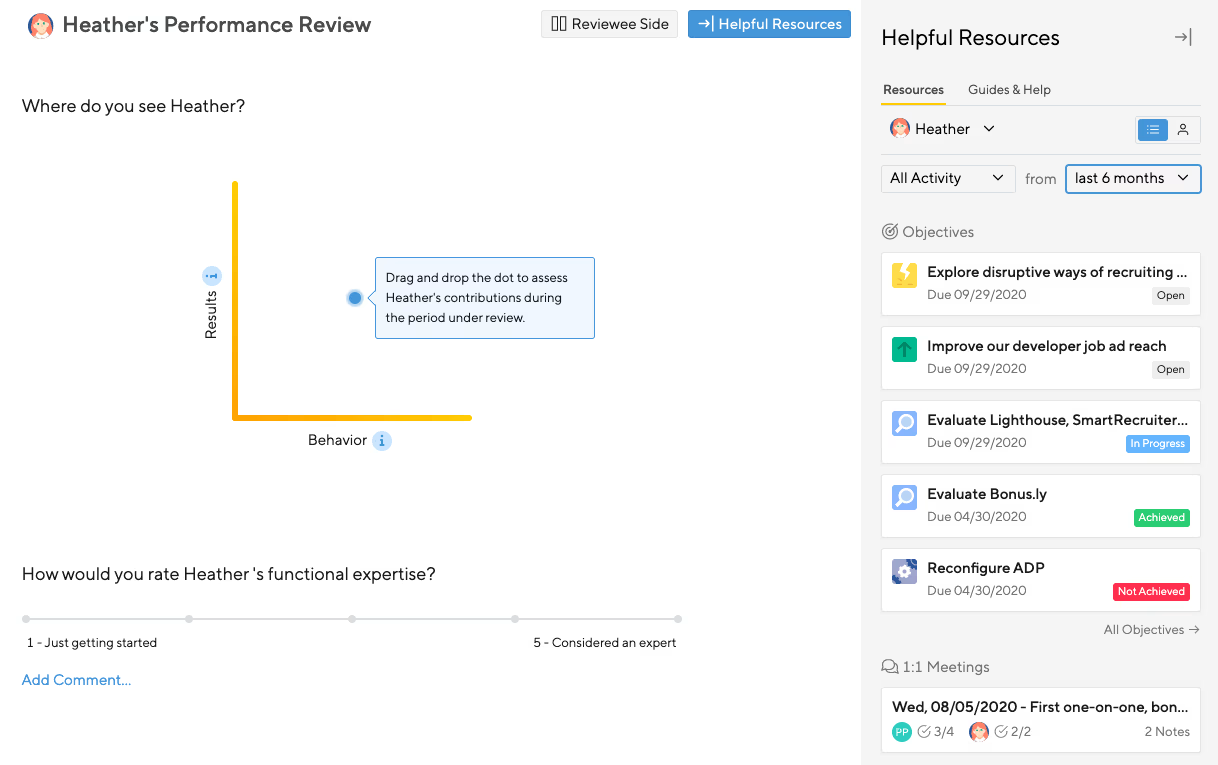
Small Improvements is a lightweight performance-management platform for teams of 10 – 350 employees. Used by 1,000+ teams at companies like Duolingo, Zapier, and SoundCloud, it streamlines reviews, 1-on-1s, objectives, and 360 feedback without the setup burden of larger HR suites.
Small Improvements Key Features
- All Information in One View: Managers can see objectives, past achievements, peer feedback, and 1:1 notes directly within the review form. This reduces recency bias and provides a more complete picture of the review period.
- Expectation Alignment with 2D Graphs: Employees and managers plot their views on a customizable x–y graph. Comparing the two points helps reveal gaps in alignment and sparks clearer, more grounded performance discussions.
- Flexible Review & Check-In Settings: Customize review questions, show or hide self-assessments, schedule reminders, and adjust workflows to fit your internal process.
- Guided Reflection Templates: The platform includes prompts and templates that help employees reflect thoughtfully instead of rushing through the review.
- Progress Tracking Dashboard: Track who has started or completed reviews, send reminders to lagging managers, export rating data, and monitor overall participation.
Why We Chose Small Improvements?
We chose Small Improvements because it keeps performance management simple without sacrificing clarity. The 2D expectation-alignment graphs immediately stood out—they turn uncomfortable review conversations into productive, transparent discussions. The unified view inside the review form also solves a common issue: managers often struggle to remember achievements from earlier in the year. With everything in one place, feedback becomes more fair and accurate. For small to mid-sized teams that want an easy, lightweight platform with structure but not complexity, Small Improvements delivers exactly that.
Pricing Details
Small Improvements starts at $3 per user per month and includes a 30-day free trial with no minimum seat count.
11. Trakstar
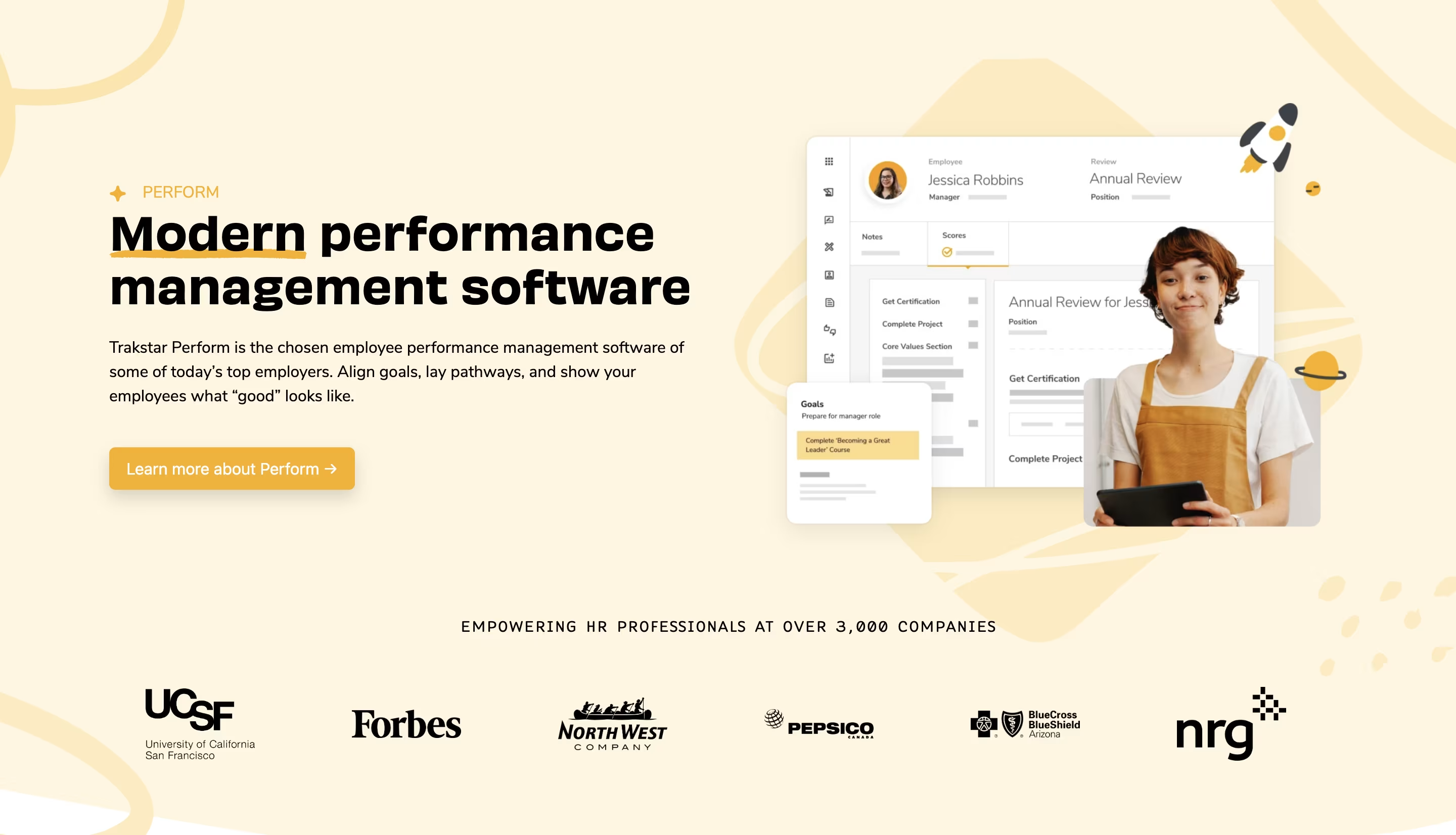
Trakstar Perform is a performance management platform built to help organizations set clear expectations, track goals consistently, and keep employees engaged through regular feedback. It reduces administrative work and gives HR teams the structure they need to drive accountability, alignment, and long-term growth across the organization.
Trakstar Key Features
- Performance Reviews Aligned to Business Goals: Create review cycles that connect directly to company goals and competencies. This makes expectations clear for every role and department.
- Continuous Feedback & Check-Ins: Supports frequent manager check-ins, note-taking, and real-time feedback so conversations don’t get limited to annual or semi-annual reviews.
- Automatic Reminders & Workflow Automation: Automates reminders, approvals, and review steps so nothing gets delayed. Integrations with communication tools help keep everyone on track.
- Reports, Insights & Benchmarking: Dashboards show performance trends, participation rates, and review status. Benchmarking tools let you compare performance metrics across teams or peer groups.
- Job Descriptions & Role-Based Expectations: Stores job descriptions centrally and links them to goals or review criteria, reducing confusion about what success looks like in each role.
Why We Chose Trakstar Perform?
We chose Trakstar Perform because it brings clarity into every part of the performance process. The ability to link job descriptions, goals, and competencies makes expectations easy to understand and evaluate.We also liked how benchmarking and insights help leaders spot trends and identify where teams need support. For organizations that want a straightforward, structured system to drive accountability and continuous feedback, Trakstar Perform is a dependable fit.
Pricing Details
Trakstar doesn't offer upfront pricing, so you'll need to ask them for a quote.
12. PerformYard
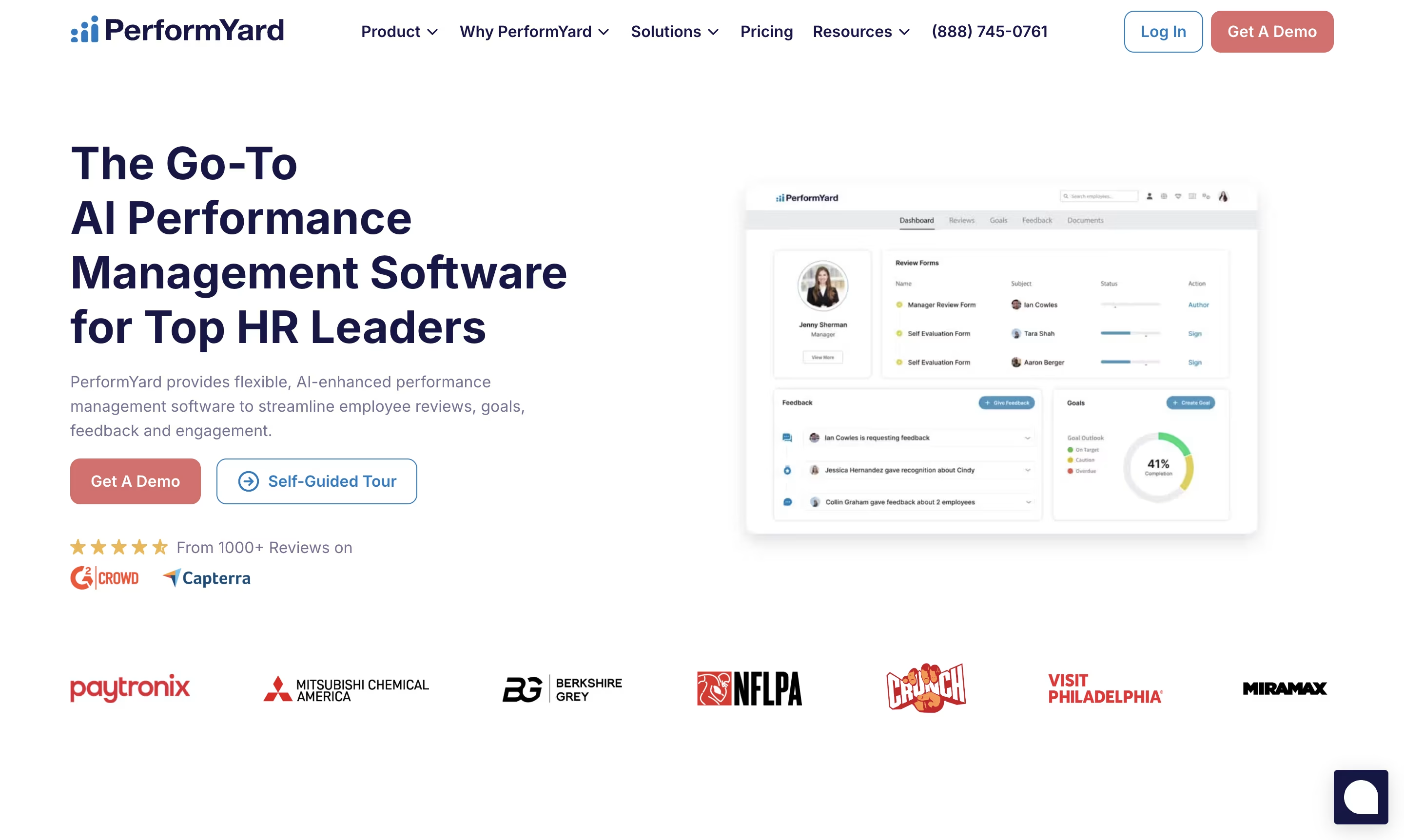
PerformYard is built to make performance management easier for HR teams and more meaningful for employees. It works well for organizations of all sizes that need both structure and flexibility. The platform supports everything from formal reviews to ongoing feedback, giving managers and employees a clear, consistent way to align and grow.
PerformYard Key Features
- Reviews & Check-Ins: PerformYard supports formal performance reviews (annual, quarterly, project-based) plus frequent check-ins and 1-on-1s. This lets teams keep performance conversations regular, not just limited to big review moments.
- Goal Management: You can set goals (including goal check-ins), cascade goals across teams, track progress, and link them to larger company objectives.
- 360-Degree Feedback & Continuous Feedback: Peer feedback, self-assessment, upward feedback — PerformYard supports these. Employees can also request feedback and managers can give recognition or notes continuously, not just during review cycles.
- Reporting & Analytics: Dashboards show trends, review completion rates, goal progress, etc. These insights help HR/leadership spot issues early, see what’s working, and decide where to support or adjust.
- AI Enhancements: PerformYard includes AI tools to speed up writing review responses, summarizing feedback, improving tone, etc. These help reduce reviewer fatigue and improve consistency.
- Customization & Workflow Flexibility: You can import existing review forms or build custom ones. Also, review cycles, question types, visibility settings (who sees what, when), are customizable to match what your company needs.
- Ease of Use & Support: Generally rated highly for usability. PerformYard has clean dashboards, reminders/notifications so tasks don’t get missed. Also, dedicated customer success/support help during setup and ongoing use.
Why We Chose PerformYard?
We chose PerformYard because it strikes the right balance between structure and flexibility—something many performance tools struggle with. The customization options make it easy to match your exact review process without adding complexity. The AI-assisted writing and feedback tools also stood out, especially for reducing reviewer fatigue during busy cycles.
We appreciated how PerformYard keeps performance conversations active year-round and provides clear insights for HR and leadership. For teams that want a flexible, easy-to-use platform that adapts to their workflows, PerformYard is a strong choice.
Pricing Details
PerformYard pricing starts at $5–$10 per person/month, billed annually.
What is a Performance Management Software?
Performance management software is a digital platform that helps organizations track, evaluate, and improve employee performance. Instead of relying on manual reviews or scattered tools, it brings everything into one place. Most platforms include features such as goal setting, continuous feedback, performance reviews, 360-degree feedback, analytics, development planning, and recognition tools.
Features to Look for In a Performance Management Software Platform
The right performance management platform makes the entire process—from feedback collection to performance reviews and improvement plans—efficient and easy to manage. Here are the key features to look for:
1. User-Friendly Interface
The software should be simple enough for managers and employees to use without hours of training. A clean, intuitive design boosts adoption and reduces resistance.
2. Customizability
Every company measures success differently. Choose a platform that can match your workflows, KPIs, values, and review formats.
3. Goal Setting & Alignment
A strong platform helps you set clear goals, connect them to company objectives, and track progress. This alignment keeps teams focused and ensures everyone understands what success looks like.
4. Regular Feedback Mechanisms
Most employees prefer ongoing feedback, not once-a-year reviews. Platforms with continuous check-ins help employees grow steadily and feel supported throughout the year.
5. 360-Degree Feedback
This feature gathers feedback from managers, peers, direct reports, and sometimes clients. It provides a complete picture of performance and helps employees compare their self-perception with how others see them.
6. Reports & Analytics
Robust reporting turns performance data into actionable insights. Dashboards help managers spot high performers, identify skill gaps, and monitor team progress. For employees, seeing progress visually makes performance feel more objective and motivating.
Benefits of Performance Management Software
A performance management tool does more than streamline reviews — it helps organizations grow stronger, keep employees engaged, and make smarter decisions. Here are the key benefits:
Organizational Performance
- Strategic Alignment: These tools connect individual goals to company-wide objectives. When employees see how their work supports the bigger picture, their efforts become more focused and impactful.
- Data-Driven Decisions: Instead of relying on gut feelings, managers get real performance data. This helps with workforce planning, resource allocation, and shaping long-term strategies.
- Boosted Productivity: Clear goals and regular feedback cut down on confusion. Bottlenecks are easier to spot, and best practices can be shared across teams, leading to higher output.
Employee Development
- Targeted Skill Building: Tools highlight skill gaps, making it easier to create personalized training and development plans.
- Career Path Visibility: Employees get clarity on what they need to move forward — skills, milestones, and achievements. This visibility motivates them to stay and grow.
- Culture of Learning: Frequent feedback cycles keep growth ongoing, not limited to annual reviews. This builds a culture of continuous improvement.
Engagement and Retention
- Higher Engagement: Recognition and regular feedback show employees their work matters, which drives motivation and commitment.
- Lower Turnover: Clear growth opportunities and transparent evaluations reduce frustration, improving retention and cutting hiring costs.
- Better Work-Life Balance: By simplifying processes and reducing admin overload, these tools free up time and make flexible work arrangements easier to manage.
How to Implement a Performance Management Software?
Rolling out performance software works best when you treat it like a change program, not just a new tool. Use this simple plan:
1. Clarify the outcome
Don’t just say “we want better performance reviews.” Spell out what better looks like. Start by asking:
- What’s broken today? (e.g., review cycles drag on for months, feedback is vague, goals aren’t aligned)
- What should change? (e.g., complete reviews in 4 weeks, track goals quarterly, managers give at least 2 feedback touchpoints per month)
- How will we measure success? Define success metrics before rollout. For example:
- Shorten review cycle time by 30%
- Achieve 80%+ completion on quarterly check-ins
- Link 90% of employee goals to company OKRs
By setting clear outcomes, you avoid vague expectations and create a yardstick to evaluate whether the software is working.
2. Map the process you have today
List your current steps: goal setting, check-ins, reviews, calibration, rewards. Note what’s working and what causes friction. This tells you what to keep, fix, or retire in the new system.
3. Secure executive leadership buy-in
Ask one senior leader to be the visible owner. Have them announce the “why,” set expectations, and model usage. Sponsorship reduces resistance and speeds adoption.
4. Choose owners and champions
Assign an admin (HR or Ops), a small pilot group of managers, and a few “champions” in each department. Champions answer questions and collect feedback in the first months.
5. Start with a focused pilot
A pilot isn’t just a test run — it’s where you debug processes and build champions. Choose 1–2 departments that represent different working styles (e.g., a sales team for fast-moving goals, and an engineering team for project-based goals). Run a full cycle with them: goal-setting, check-ins, and reviews.
During the pilot:
- Track adoption rates (how many set goals, how often check-ins happen, completion rate of reviews).
- Collect structured feedback from managers and employees. Ask: What was easy? What was frustrating? What should change?
- Document quick wins (e.g., “weekly check-ins cut meeting time in half”) and pain points (e.g., “rating scales felt confusing”).
A successful pilot gives you data, stories, and allies to scale the rollout. Without this step, you risk launching company-wide with avoidable friction.
6. Set up the essentials
- Configure goal templates and rating scales
- Turn on 1:1 agendas, check-ins, and reminders
- Connect core systems (HRIS, SSO, Slack/Email)
- Define data permissions and retention rules
7. Train by role, not just features
Too many rollouts fail because training focuses on buttons to click rather than jobs to be done. Instead, design training for each role’s needs:
- Managers: Show them how to set SMART goals with their team, give constructive feedback in the system, and use reporting to spot coaching opportunities. Emphasize time saved compared to their old process.
- Employees: Teach them how to write clear goals, request peer or manager feedback, and prepare for reviews. Keep it practical — focus on why the system makes their work easier and their contributions more visible.
- HR/Admins: Cover workflow setup, data security, calibration tools, and reporting dashboards. HR needs confidence in customizing templates, handling exceptions, and troubleshooting.
Tip: Replace long slide decks with short role-based videos, quick reference guides, and live Q&A sessions. People learn faster when they see what matters to their job.
8. Communicate early and often
Share a simple rollout timeline, FAQs, and “what changes for me.” Use quick Loom videos or slides. Keep updates flowing during the first cycle.
9. Measure, learn, and iterate
Review adoption metrics monthly: goal coverage, check-in completion, review cycle time, feedback volume, user satisfaction. Adjust templates, reminders, and training based on what you see.
10. Scale and lock in habits
Roll out to the rest of the org. Add advanced pieces later (360s, career paths, compensation links) once the basics run smoothly. Celebrate teams that hit high adoption and share their playbooks.
Recent Trends in Performance Management
Performance management is changing fast. New technologies, employee expectations, and workplace shifts are reshaping how organizations approach performance and growth. Here are the most important trends shaping the space today:
1. Shift from Annual Reviews to Continuous Feedback
Source: ClearCompany, 2023
Annual reviews are declining—from 82% usage in 2016 to 54% in 2019. Companies that adopted continuous feedback saw a 40% increase in engagement and a 26% improvement in performance. Teams now prefer real-time feedback that’s timely, actionable, and aligned with fast-moving work environments.
2. Rise of AI-Powered Performance Tools
Source: PeopleFluent, 2024
Organizations using AI in performance management are twice as likely to outperform those that don’t. AI supports more objective evaluations, personalized development plans, and reduced bias. As adoption grows, reviews are becoming smarter, faster, and more tailored to each employee.
3. Manager–Employee 1:1s Are Replacing Traditional Reviews
Source: HR.com, 2024
41% of companies now prioritize frequent 1:1s over annual reviews. Regular conversations strengthen relationships, improve alignment, and make it easier to adjust goals quickly—especially in hybrid and remote environments where communication gaps can widen.
4. Continuous Feedback Is Driving Retention and Engagement
Source: Betterworks, 2020
Organizations with frequent, meaningful feedback report 44% better retention and 39% higher talent attraction. Younger employees—especially Gen Z and millennials—expect feedback weekly or even daily. This trend supports a culture built on trust, clarity, and ongoing learning.
5. Personalized Development Plans Are Boosting Retention
Sources: IBM, 2023; Unilever, 2023
Personalized Development Plans (PDPs) are becoming a standard. Companies using PDPs see 40% higher performance, 30% higher satisfaction, and up to 82% improvement in retention. As skill gaps widen, employees want individualized growth paths, not one-size-fits-all ratings.
6. Bias in Traditional Reviews Is Fueling System Overhauls
Sources: SHRM, 2023; Textio, 2023; Bonusly, 2023
Studies show women receive 22% more personality-based feedback and are 28% less likely to receive top ratings. Black and Latinx employees receive 2.4x more non-actionable feedback. These disparities push companies to adopt structured, transparent, and data-driven review systems that reduce bias and improve fairness.
Conclusion
Choosing the right performance management software is a key step toward building a culture of continuous improvement and long-term success. The 12 platforms we covered show how much flexibility exists today—from lightweight tools to full-featured systems. As you compare your options, focus on the solutions that fit your culture, support your growth goals, and make performance conversations easier and more meaningful.
With the right platform in place, you can develop talent more effectively, boost engagement, and build teams that consistently perform at their best.
Here’s to creating and retaining truly high-performing teams.
















